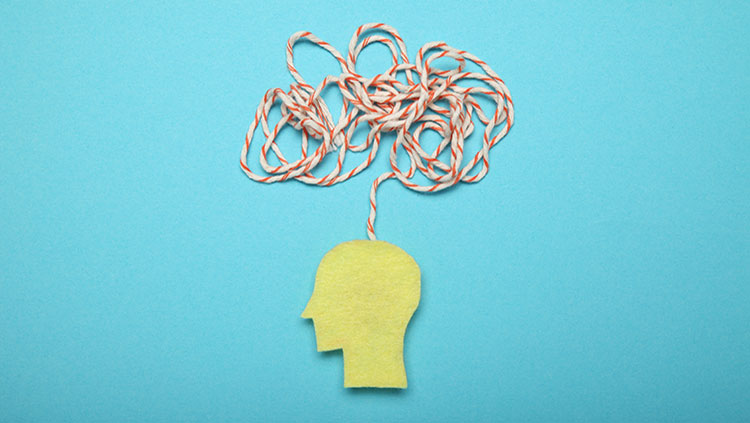Why Doesn’t the Brain Have Nociceptors?
- Published3 Feb 2021
- Author Rina Diane Caballar
- Source BrainFacts/SfN

For most major surgical operations, patients receive anesthesia and drift out of consciousness so they don’t feel any pain during the operation. But, as the name suggests, awake brain surgery works differently. Patients are sedated while the skull is being removed and later reattached but are awakened in between. This helps surgeons map the function of the exposed brain area so they can differentiate between healthy brain tissue and, for instance, a tumor that needs to be removed. Doing surgery this way lowers the risk of lasting sensory, cognitive, or motor problems as a result of unnecessarily removing healthy tissue.
While it may seem strange, this surgery is possible because the brain doesn’t have pain receptors — also known as nociceptors. Patients undergoing this procedure don’t feel pain when doctors operate on brain tissue. Some people can even answer questions or play an instrument during the procedure.
To better understand nociceptors, how they work, and why the brain doesn’t have any, BrainFacts.org spoke with Janet Bultitude, senior lecturer in cognitive and experimental psychology at the University of Bath.
What are nociceptors?
Nociceptors are neurons or nerves that respond to noxious stimuli. Noxious stimuli are things that could potentially damage the body like extreme heat, cold, or pressure. By responding to possible threats, nociceptors help protect our bodies.
We have nociceptors in different parts of our body. Some — called visceral nociceptors — can be found within internal organs. But more of our nociceptors are found in our skin and joints. This could relate to the role of the skin and joints in exploring our environment and that we are more able to do something about threats coming from outside our body than potential harm that is happening in our organs.
We can describe nociceptors by the types of harm they are sensitive to. Thermal nociceptors respond to changes in temperature, like when you burn your hand. Mechanical nociceptors respond to changes in pressure, such as when something heavy falls on your foot. Chemical nociceptors respond to chemical changes, like eating spicy foods or rubbing a strong chili on your skin.
What’s the difference between nociception and pain?
Nociception is the nerves’ response to stimuli, while pain is the subjective experience we have when our brain interprets the signals from these nerves.
Let’s say you burned your hand, accidentally cut it, or dropped something heavy on it. Nociceptors would response to these possible sources of damage. A nociceptor’s signal then travels to spinal cord neurons. These neurons control the flow of nociceptive signals between the body and brain and relay nociceptive information from body parts to the brain. The brain then interprets the location of the stimulus on the body, and what it might mean. A network of areas in the brain are involved in this, including the primary and secondary somatosensory cortices, the insula, the anterior cingulate, the prefrontal cortices, and the thalamus.
Pain isn’t a simple one-to-one response when a nociceptor is activated — emotional, psychological, and social factors will affect the meaning of the nociceptive signal and the person’s response to it. Our state of mind, background, and other factors can influence our pain experience. For example, when you’re sad, your pain may feel worse, but you might tolerate pain better when you’re happy. You could experience pain differently depending on the people around you and how they respond. When a child stumbles, they might cry harder and feel more pain when a parent is present. But they may handle the pain better if their parent doesn’t fuss about it.
Does the brain have nociceptors?
The brain doesn’t have nociceptors. Maybe we evolved with no nociceptors in the brain because the brain doesn’t need to directly feel a threat of damage to it. Other structures in our body do that instead.
Even though the brain doesn’t have nociceptors, it’s still protected from damage. It floats in cerebrospinal fluid, which provides some cushioning in case of a sudden blow. The entire brain is wrapped in cellophane-like membranes, called meninges, supplying another layer of protection. All these are housed inside the skull forming a hard barrier between the brain and the outside world. Nociceptors in the meninges and other structures in the skull can signal damage to them and other neighboring structures, and by extension the threat of damage to the brain.
Since the brain has no nociceptors, does this mean it can’t feel pain?
Our brains don’t have nociceptors, but the brain is “feeling” pain because it evaluates and interprets the signals from the body. In a sense, our brain is the only part of the body that “feels” pain.
Why do we have headaches if the brain has no nociceptors?
Many structures in our head have nociceptors, including blood vessels, muscles, the nerves in our face and neck, and the meninges.
BrainFacts.org welcomes all your brain-related questions.
Every month, we choose one reader question and get an answer from a top neuroscientist. Always been curious about something?
Please submit your question by filling out this form.







